I feel as if I have been away forever. Life overtook my Art and Perception, although not completely my art and not completely all my perceptions.
So here’s an update.
After a long struggle with health and painting, I’ve finally revived and have been painting the landscapes of the Willamette Valley in western Oregon. The change of venue from the wild and awesome desert to the gentle scenery of the Valley was fairly traumatic and also the cause (I think; I hope) of some really bad paintings, now discarded. But I’ve kept a few and think I may be able to tolerate the pretty landscapes and conventional views to which I’ve been subjected. (I’m engaged with a group of plein air artists who always choose not to paint the snarky or sardonic.)
The paintings imaged below have been done since the end of June. The first four (through the Storm) were attempts to provide a sense of expansion outward rather than focusing into the painting. This outward away from the center is what I feel the desert does, and I thought painting sky and/or water might keep me in touch with that expansion of space so essential to desert painting.
Morning Fog in the Gorge, 12 x 16″, Oil on board, 2009
Sailboat on the Mighty Columbia, 12 x 16″, Oil on board, 2009
Oak Island on Sauvies Island, 18 x 24″, Oil on board, 2009
Storm over Sauvies Island, 12 x 16″, Oil on board, 2009
Then, I spent four days last week in Vancouver, BC (Canada) and chanced upon an exhibit of Emily Carr drawings at the Vancouver Art Gallery.
I’ve long been a fan of Carr, although she was very poor andpainted on brown paper with oils thinned with gasoline. The original paintings are almost always a disappointment because they have deteriorated over the years.
However, the Vancouver exhibit was of her drawings, and frankly I was stunned by them. (I had gone to the Gallery to see an exhibit of 17th century Dutch paintings, which were quite exquisite, but none of them stunned me). I returned to Portland to the centennial celebration of a pleasant park on an extinct volcano in my neighborhood. It’s fairly large, almost entirely treed, with some very distant vistas and three reservoirs. Before I went to Vancouver, I thought painting Mt. Tabor was a challenge I was likely to fail to meet. I was reduced, prior to last week, to painting gates:
Salmon Street Gate, Mt Tabor, 12 x 16″, Oil on board, 2009
And pictures of the “mountain” from a distance, with lots of city flotsam:
Mt Tabor from Hawthorne and 28th, 12 x 16″, Oil on board, 2009
(There’s another, larger, version of this which I think is better, but haven’t photographed yet)
However, after seeing the Carr drawings, on Saturday I tackled the forest that is Mt. Tabor’s proudest achievement:
In honor of the Mt Tabor Centennial 1, Oil on board, 12 x 16″, 2009 (draft1)
In Honor of the Mt Tabor Centennial 2, 12 x 16″, Oil on board, 2009
And among the gentle conventional landscapes, I managed a few Underwood whacks:
Bonneville Artifacts, Columbia Gorge, 12 x 15″, Oil on board, 2009
And before I took on the gentility, I did some plein air city work, which seems more like my old self:
The East Branch, Portland Public Library, North Side, 12 x 16″, Oil on board, 2009
The East Branch, Portland Public Library, West Side, 12 x 16″, 2009
The East Branch, Portland Public Library, South Side, 18 x 24″, Oil on board, 2009
The East Branch, Portland Public Library, East Side, 18 x 24″, 2009
I did another painting of the front (the north side) of this building from a photograph, mostly so I could paint (and hence capture in my brain) the front of the building minus the trees. The East Branch of the Portland Public Library was built in 1911 by a locally prominent architect who also built the central library, which is still in use and still quite magnificent. The east branch has fallen onto lesser times, having its large open central hall (a requirement of all Carnegie funded libraries) divided into two floors. Only the rear rotunda, truncated to make a very strange room, was left intact. The paintings were done from awkward spaces — the last from the edge of a parking lot that bordered on a plaid pantry; the first in a parking lot next to a cement block commercial building. The south side shows the rear of the library behind the Coffee Systems company, also in a cement block building. Two major streets, 11th and Morrison, border the block on which the library stands and to its east is the Rimskykorseykoffee House, which resembles a haunted bordello.
All this is to say that while I was placed by my group in gentle breezes and loving landscapes, when I could I escaped to my natural milieu, the snarky somewhat sardonic city in which I really live. I even am thinking of doing one of my wild studio composites with that wonderful ironic ex-library.
And how are you spending your summer creativities? Snarky or genteel? Admiring the river as it rolls by or watching the semi’s, rolling toward the center city?
Jer and I are, god willin’ and the crick don’t rise, returning to the desert, to Beatty Nevada, in November, for another go at the Amargosa Playa. I have notions that have nothing to do with comfort and pleasing vistas. Although the vistas of the desert are, in my perception if not my art, very pleasing.

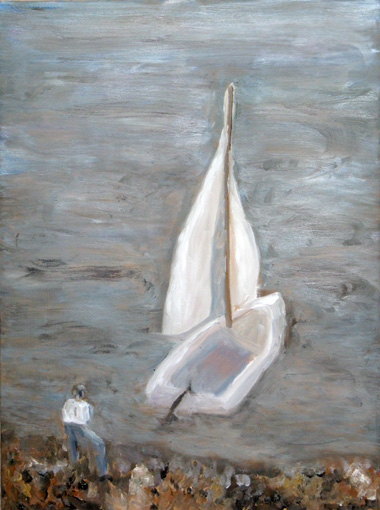

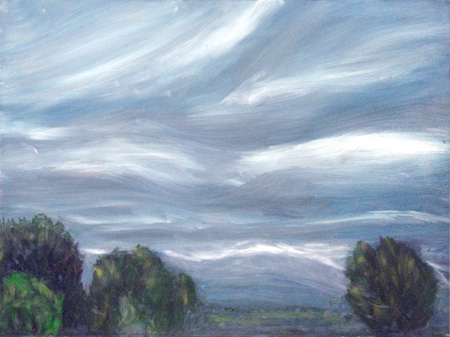
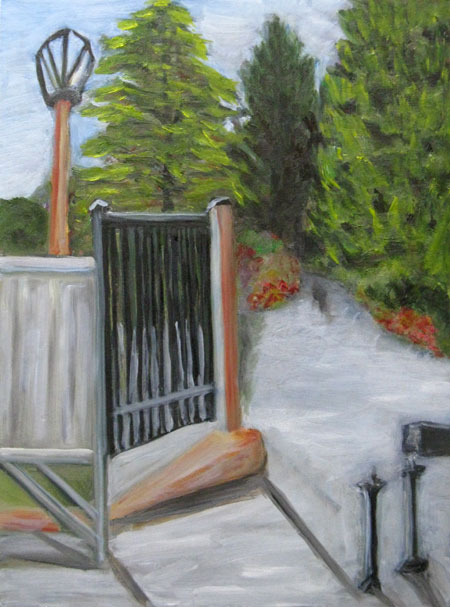

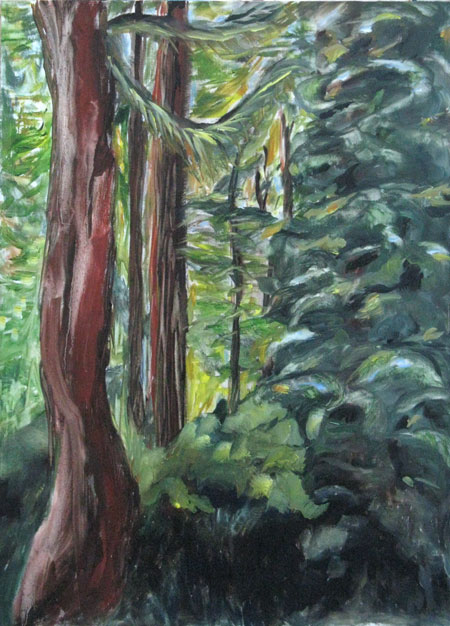

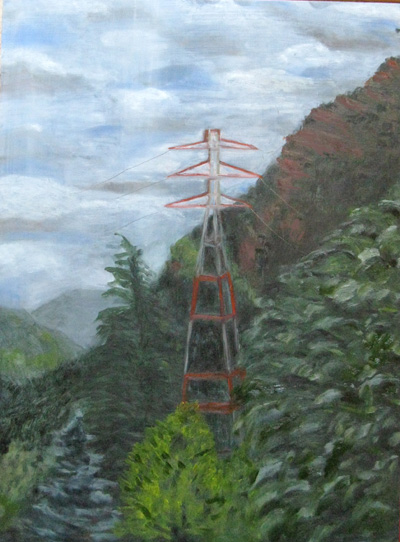

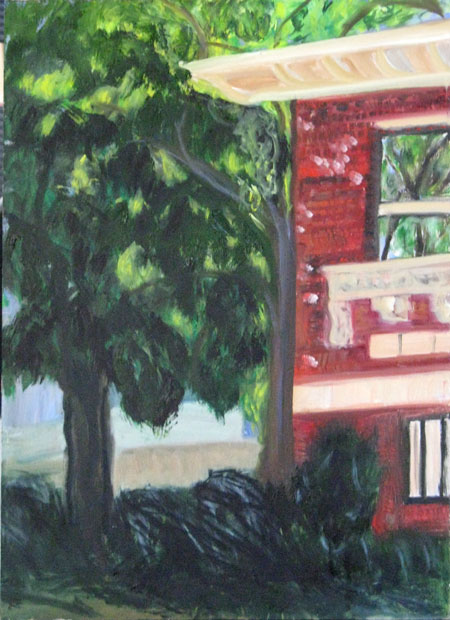
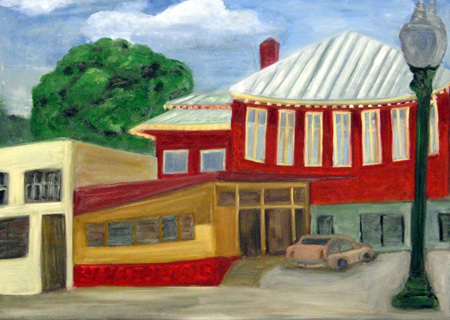
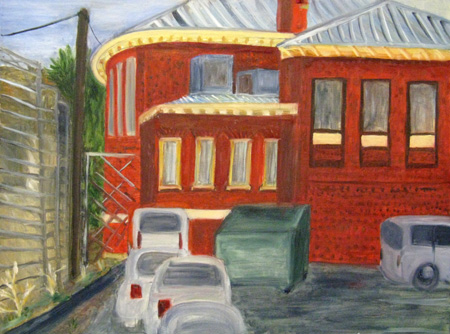

June:
Good to hear from you again. You succeeded in awaking A&P from a fairly long slumber.
I want to take the time to sufficiently go over your recent efforts. But in the meanwhile, have you exhibited at the Barn in Athens, O.? I ask this because an exhibitor at a local art fair had come up from southern Ohio and I asked her about the Barn (Dairy Barn?). A look of intense longing crossed her face as she spoke of someday exhibiting there. I mentioned you in connection with the Barn and she was greatly taken by the very thought. All that without really knowing if you showed there or just visited.
Hi Jay,
Sorry to give everyone such a rude awakening. I’ll try to sing more often from now on, so be prepared — ear plugs, perhaps.
Indeed, the Dairy Barn is an incredible exhibit of quilted art [says she who has actually exhibited there.] It’s perhaps the premier, and certainly the best established, of all the quilting art exhibits in the US, maybe the best (as fine art) in the world. It was the earliest place that recognized the potential for fine art in what quilters were doing with fabric and has consistently held us to the highest standards outside of — well, New York (or Cleveland) galleries.
The exhibit is formally known as “Quilt National” (held at the Dairy Barn near Athens, Ohio, and also very near old Ohio State lunatic asylum). It’s held every other year, alternating with another prominent exhibit, “Visions,” on the west coast. Thousands of people enter; I sent in my entries (gave my charitable fee, as it were) from about 1995 on and in 2005, got in.
The notice of acceptance came in an email and was so unexpected I let out a squeal that brought Jer running to see what disaster had happened.
In 2006 I went a-painting at the John Day Fossil Beds in the high desert in eastern Oregon and since then haven’t done the quality of textile work that I would want to enter into QN. Besides, I actualy got in once — I’d hate to get the usual rejection letter –snort–
So I spoke with verity.
Hi June,
Your commentary is, as always, provocative. I’ve been giving some thought to the eternal “what is art for?” question and coming to the conclusion that, for me, art is refuge, haven from the overstimulating, snide, bumpy, jagged, ironic (which is becoming a synonym for “sarcastic”, which is a shame), in-your-face components of day-to-day living. This is not the same as facile prettiness, serenity is a difficult and valuable practice. Having just been through a very harrowing time, I was especially drawn to your water and trees. The tree portraits, I think, are especially dynamic (esp. Centennial 1)
I also wondered — how did you first experience Carr’s work? I’m assuming it was through reproductions of the images before they became so deteriorated. Is that the case? If this wasn’t addressed in an earlier post — what do you find appealing in her work? (If it was, can you redirect me?)
Hi Melanie,
I fear that my post was a pent-up melange of many different ideas and directions, all of which feel to me to be very very true — and likely to be replaced by whatever happens next.
I just wrote a long disquisition about my own painting temperament and ideas ( which undoubtedly would be replaced shortly by others) but decided it was too hot for disquisitions. So, about Emily Carr — I think I was first introduced to her via Doris Shadbolt’s “The Art of Emily Carr” which Canadian friends had in their library.
And then we spent some time in Victoria, BC, where her home has been turned into a museum. I thought the dim paintings I saw there were a result of bad lighting, but as I saw more paintings at the Victoria museum and at the Vancouver Art Gallery, I realized that what appears brilliant in reproductions is less so in reality.
What appeals to me is her ability to capture the power of the forest. Painting forests and the masses of greens and browns that one finds there is difficult. Painting them well is even more difficult. Capturing the power of those dark and awesome spaces is nigh onto impossible. And Carr manages that.
I grew up in and around forests on the east coast, so had some sense of the space and underwater light and awesome presence that they can engulf you with. So finding Carr was like finding a voice that I didn’t know existed.
Here are a couple sites to get you started with Carr. As you will see, in the ninteen teens, she did a lot of recording of the First Nations’ art on the north and western edges of Vancouver Island. She did little painting for about 10 years, returned to it in the late 1920’s and then was discovered by eastern Canadian artists, who turned her talent toward the forest, semi-abstracting it in an attempt to discover what she called its “spirit.” Her best work dates in the 1930’s and early 40’s. She died in 1945.
http://www.svreeland.com/fl-paintings.html
http://www.groupofsevenart.com/Emily_Carr/Emily_Carr_prints_for_sale.html
There are many more sites with images of Carr’s work and she herself wrote a number of books, many of them autobiographies. She was a true eccentric and a magnificent figure as well as being a great artist.
June:
Can you say something about your decision making when painting: in terms of when, and maybe where, in your sequence of actions leading up to a finished product?
Jay,
I’m not sure exactly what your question is directed at — the finished product? or the process?
But I’ll talk about decision making and maybe that will approach what you’ve queried:
I decide wjere to paint mostly by external conditions, tempered by my own temperament.
I am doing a plein air group sort-of-class that meets once a week at some place determined by the instructor. So I go to the designated place, usually somewhere scenic, and then tap into my own obsessions to deal with the scenery.
The Mt Tabor centennial celebration gave me a week’s obsession with trees; the week had been designated by the celebration’s organizers as “paint-out week”, leading up to the exhibit, and I am by nature attracted to obsessed projects, times when I push very hard and then completely relax. So I did 10 paintings in 7 days (took two days off and only painted a single painting on Wednesday when it was 106 degrees). And I painted mostly trees.
I find that returning to a subject again and again produces better results for me — hence trees or the Amargosa playa or urban-scapes with interesting buildings changed by time and human activity.
I often come to some ideas about what I want my paintings to evoke, although not always. For example, in the trees that I painted all last week I would have liked to capture something of the power, the “spirit” of the forest, ala Emily Carr. Alas, I think I managed only the lively writhing nature of the city park. Something of the power got picked up on the hottest day, when I was working on the old-growth cedars, but the rest of the time, it was mostly active movement that I grabbed with my paintings.
Does that respond adequately to your question? Perhaps I should do another post of just that one week’s obsessive painting of the park….
Hi June,
Having done my first landscape, no ducks, people or boats, I have come to realize how difficult it is to put a focus into a landscape as you do in your first picture “Morning Fog in the Gorge”.
Birgit,
This might be The Problem in landscape painting. That’s why painting books love the “z”-shaped or curved road or path into the landscape, nice rich mysterious deep shadows at the focal point, and/or selectivity and simplification. Advice, I’ve found, is easy; doing it is hard! The river helped in that first painting, but trees, unless parted by paths, are difficult, as my last week’s work can attest. Steve has always managed trees and foliage well in his photographs, sometimes through the rhythms of overall patterning.
Is rhythm the keyword?
Birgit,
Rhythm may well be the key, although there’s also negative space and shape to be considered.
I always think of Pollock when I think of overall complexity, but thinking of him doesn’t help me paint well. Squinting at the scene to make the details murky and thinking of masses as forms/shapes helps me more, particularly when I’m faced with unfocused, overall scenes. But I’m still learning. We should go back and study Steve’s photos.
June,
I am waiting for another Old Holland paint to apply a glaze to my first landscape painting, hoping that it will help.
I love glazes. And they sometimes have performed miracles for me.
The forward Mt. Tabor tree (Centennial 1), singled out by Melanie, reminds me–having recently sat through a 3-movie marathon (entended versions) of LOTR (Lord of the Rings)–of an ent. Your vegetation is quite lively in the other pictures also. I don’t know Carr, but “power of the forest” is certainly something your pictures evoke. Or perhaps not exactly power, but more life force or intensity. There’s even a hint of this through the fog in the first painting. If it seems to be, as you say, more “active movement” than solemn monumentality, perhaps that’s the painter coming through the subject. Ten paintings in seven days!
Steve, no greater compliment than a painting reminding you of an ent — one of the family’s great companion mythic figures. You are almost certainly right about the painter coming through the subjects, which sometimes kind of writhe.
And you did catch my brag — sometimes I can’t resist, particularly when I feel like I’ve made an heroic effort. What I don’t mention is that I fall into a stupor after such an effort and laze around eating cherries and watching the spiders spin their webs. It seems to be a hangover from my college days when I pulled all-nighters before the tests and slept three days afterwards. In some activities, I seem to continue those age-old patterns.
Good to hear from you.
Glad to see you back. I got a kick out of your efforts to find something worth painting in the “pretty landscapes and conventional views to which I’ve been subjected”. I have the same trouble. I can paint it, but why make another pleasant painting? I think that’s why I like the stark western landscape. So many odd things out there. The challenge is to find the odd interesting things in the lush suburban landscape that surrounds me in the northeast. I discovered Emily Carr about 10 years ago by wandering into a slide lecture at RISD, her work blew me away, projected large and light filled. I’m sorry to hear that its deteriorated, she was one of the best painters of “green” I’ve seen. You did very well in your tree studies though, you really give a sense of the forest.
I’ve got another residency this fall at Great Sand Dunes National Park in Colorado. I’m looking forward to the lack of vegetation and the dramatic shapes.
Hi Kathy,
Hey good to hear from you. I meant to write back to you about the painting that you gave to Mesa Verde. It seemed just right to me when I looked at it a few months ago and now seems even more right. I know you struggled with the problem, but I think you got it right. The Great Sand Dunes should be an interesting set of new challenges — how to make them interesting without losing what they are. But that’s often the challenge, isn’t it? Not much human intervention to pester you there, I suspect. But then, I haven’t seen the dunes since, ummmm, 1972?
I found your Mesa Verde painting again on your blog, so I’m going to post the very long url: I hope it takes. It seems to me that you and I work with some of the same issues. Your website images of the city are wonderful — I hadn’t seen them before. You are capturing something there that intrigues me. Here’s the Mesa Verde link for A&P readers:
http://hodge-artandnature.blogspot.com/search?updated-max=2009-06-14T17%3A59%3A00-04%3A00&max-results=7
I continue to work on Carr — god willin’ and the crick etc. — I may post here again tomorrow or Saturday about what I’m learning. Mulitple viewpoints, among other things.
We’ll be going back to Nevada in November — always up for more difficulties. Just about the time I may have something about greens down, I’m going back to tans and grays. But I think maybe Carr has something to teach me about the void — connecting to the sublime as Edmund Burke would define it. An old A&P topic — I may have to revisit it.